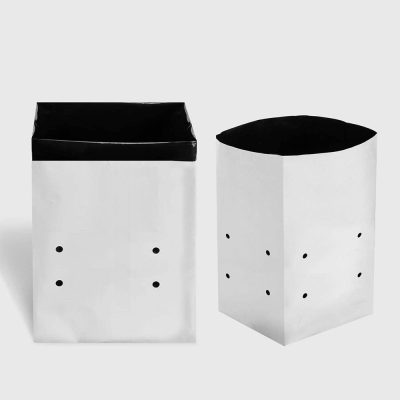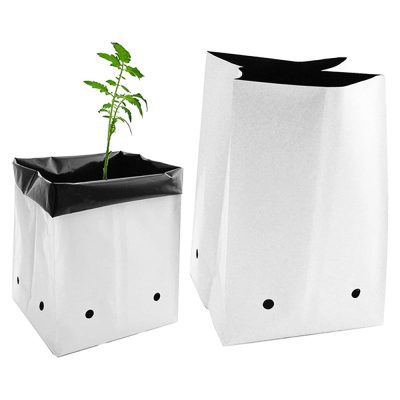Plastic grow bags offer several benefits and drawbacks for planting. Let’s explore them:
Benefits of Plastic Grow Bags:
- Affordability: Plastic grow bags are generally more affordable compared to other types of containers such as ceramic pots or wooden planters. This makes them a cost-effective option for gardeners, especially those on a budget or who require a large number of containers.
- Lightweight and Portable: Plastic grow bags are lightweight, which makes them easy to move and rearrange as needed. This is particularly advantageous for gardeners with limited space or those who want the flexibility to move plants to different locations to optimize sunlight exposure.
- Good Drainage: Most plastic grow bags come with pre-punched drainage holes at the bottom, ensuring proper drainage and preventing waterlogging. This helps to prevent root rot and allows for better oxygen supply to the roots.
- Versatility: Plastic grow bags can be used for a wide range of plants, including vegetables, herbs, flowers, and small shrubs. They come in various sizes and shapes to accommodate different plant types and growth habits.
- Root Aeration: Some plastic grow bags have breathable or woven designs, allowing for air circulation to the roots. This promotes root health, discourages root circling, and stimulates the development of a denser root system.
Drawbacks of Plastic Grow Bags:
- Limited Insulation: Plastic grow bags do not provide as much insulation as containers made from materials like ceramic or wood. This can make plants more susceptible to temperature fluctuations, especially in extreme climates.
- Durability: While plastic grow bags are designed to withstand outdoor conditions, they may not be as durable as other materials. Over time, exposure to sunlight, weather elements, and frequent moving can cause plastic grow bags to degrade or tear.
- Environmental Impact: Plastic grow bags are made from synthetic materials derived from fossil fuels. Their production and disposal contribute to environmental issues such as resource consumption, carbon emissions, and plastic waste. It’s important to consider their impact and explore more eco-friendly alternatives if sustainability is a priority.
- Susceptibility to Heat: In hot climates or during the peak of summer, plastic grow bags can heat up quickly, potentially causing root damage or inhibiting plant growth. Additional measures such as shade cloth or insulation can be used to mitigate this issue.
- Appearance: Plastic grow bags may not have the same aesthetic appeal as other containers made from natural materials. If visual appeal is an important consideration for your gardening space, you may prefer alternatives like ceramic pots or wooden planters.
It’s important to weigh the benefits and drawbacks of plastic grow bags based on your specific gardening needs, budget, and environmental considerations. Consider using them as a practical and cost-effective option for temporary or seasonal plantings, while also exploring sustainable alternatives for long-term or permanent garden setups.








